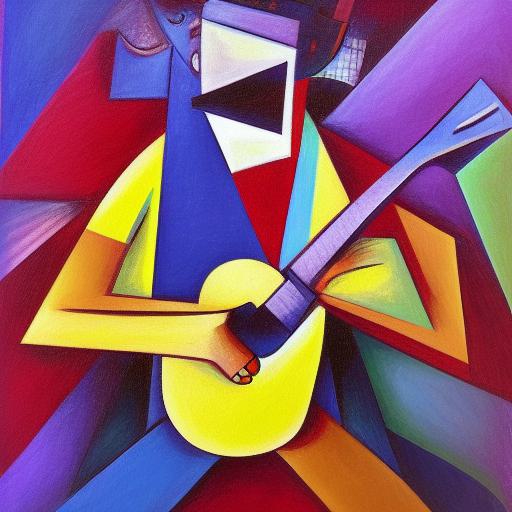How to write this prompt?
To create a prompt like the one provided, there are a few key elements to consider:
- Theme or Concept: In this case, the prompt is centered around the theme of music, specifically a man playing a guitar. The concept is further enhanced by referencing the artistic styles of fantasy painting and cubism, which will influence the way the AI generates the image.
- Artistic Style: The prompt references two specific artistic styles – fantasy painting and cubism. This gives the AI a clear direction to follow in terms of the visual aesthetics of the image. Fantasy painting is typically characterized by its whimsical and dreamlike quality, while cubism is known for its abstract and fragmented representation of objects.
- Influential Artists: Mentioning the name of a specific artist, in this case Sándor Bortnyik, can help provide additional context and inspiration for the AI. By referencing an artist who is well-known for their contributions to a particular style, the AI can gain a deeper understanding of the visual elements that define that style.
- Keywords: Including specific keywords like “instagram,” “guitar player,” “musicians,” and “musician” can help the AI further refine its understanding of the prompt. These keywords provide additional information about the subject matter and can influence the composition and content of the image.
Overall, the prompt is designed to give the AI a clear and specific direction to follow while generating the image. The use of specific artistic styles, influential artists, and keywords help to guide the AI’s creative process and ensure that the resulting image aligns with the desired theme and concept.
How did cubism become popular back then?
Cubism emerged as an art movement in the early 20th century, pioneered by artists such as Pablo Picasso and Georges Braque. Cubism was heavily influenced by the development of new scientific theories, such as Einstein’s theory of relativity and the study of optics, which led artists to experiment with new ways of representing objects in space.
Cubism became popular for its radical departure from traditional representational art, and its emphasis on the abstract and geometric qualities of objects. The movement was characterized by the fragmentation and distortion of forms, the use of multiple viewpoints, and the incorporation of text and other elements into the composition. Cubism also paved the way for other avant-garde movements such as Surrealism and Abstract Expressionism.
Who is Sándor Bortnyik?
Sándor Bortnyik was a Hungarian artist and designer who played a significant role in the development of the Hungarian avant-garde movement. Bortnyik was influenced by the ideas of the Bauhaus movement, and he worked to bring those ideas to Hungary, where he founded the Műhely (Workshop) school of art and design.
Bortnyik was known for his use of geometric shapes, bold colors, and experimentation with typography. He also made significant contributions to the development of the De Stijl movement, which focused on the use of pure geometric forms and primary colors in art and design.
How is cubism being used in graphic design nowadays?
Cubism continues to influence contemporary graphic design, particularly in the use of geometric shapes, patterns, and the fragmentation of forms. Designers often draw inspiration from cubist artists such as Picasso and Braque, and incorporate cubist elements into their work.
Cubist-inspired design can be seen in a range of contexts, including branding and logo design, packaging design, and web design. The abstract and geometric qualities of cubist design can help to create a bold and visually striking aesthetic, while the use of multiple viewpoints and fragmented forms can create a sense of depth and movement within the composition.
Are there any ethical concerns related to AI art generation?
There are ethical concerns related to AI art generation, particularly around issues of authorship, ownership, and authenticity. AI-generated art blurs the line between human and machine creativity, raising questions about who should be credited as the creator of the artwork.
There is also the issue of ownership and control, as AI-generated art may be owned and controlled by the companies or individuals who own the algorithms and data used to create the artwork. This raises questions about the use and exploitation of data and the potential for a new kind of digital divide.
Finally, there is the question of authenticity, as AI-generated art may be created using pre-existing images or data, which can raise concerns around plagiarism and originality.
How can AI-generated art be used in different industries?
AI-generated art has the potential to be used in a range of industries, including advertising, fashion, and entertainment. In advertising, AI-generated art can be used to create visually striking and attention-grabbing campaigns, while in fashion, AI-generated art can be used to create unique prints and patterns for clothing and accessories.
In the entertainment industry, AI-generated art can be used to create immersive and interactive experiences, such as video games and virtual reality environments. AI-generated art can also be used in scientific and medical fields, such as creating visualizations of complex data and medical imaging. Overall, AI-generated art has the potential to transform many industries by providing new and innovative ways to create and engage with visual content.
Enhance your designs with stunning AI-generated art using Visual Paradigm Online. With just a few clicks, you can incorporate unique and visually appealing graphics into your projects, thanks to the platform’s user-friendly interface and a wide selection of design templates and assets. Experiment with various styles and layouts until you achieve the perfect combination for your needs. Try Visual Paradigm Online today and take your designs to the next level!


